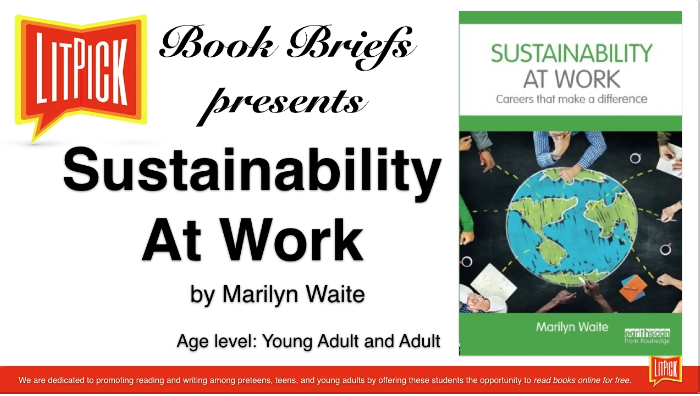
LitPick Review

Next to “How many loans did you take out?” and “Are you dating anyone?” one of the questions college students dread most is, “What are you going to do with your major?” Unless you’ve already mapped out a spreadsheet of five-year-plans, coming up with an answer can be difficult. Luckily, students interested in environmental sciences now have a brilliant resource to turn to.
Marilyn Waite’s Sustainability at Work is a comprehensive guide to turning degrees into careers. Her book clearly lays out the many paths that environmentally-focused students can take. College-age readers are advised to look at all manner of careers, from law to agriculture to healthcare. Each career section is clearly outlined and packed with helpful steps, interviews with professionals, and graphs.
Employers can also use this guide to see what they can to do recruit bright minds to power the next wave of environmental activism. In a world where global warming is sometimes referred to as a liberal conspiracy from China, it’s critical that a new generation of scientists and activists steps in to care for our home. Sustainability at Work is an invaluable resource for those who are passionate about the planet.
Opinion:
Full disclosure: I am not seeking a career in environmental science. However, my major — American history — is often subject to polite confusion as to how this will lead to anything but economic tribulation. I was curious to see how Waite would guide students who were trying to figure out which careers they could pursue without sacrificing the subjects they love.
As I do before reading any nonfiction book, I did a bit of research on the author’s background to determine credibility. Waite has an impressive résumé — Cambridge and Princeton-educated, international speaker, and devoted environmentalist. Her strong academic background shines through in Sustainability at Work. Waite’s wording and paragraph structures are clear, the chapters are logically set up, and there is a plethora of references for the mightily curious to peruse. These long lists of websites, organizations, and other resources are an excellent jumping-off point for a deep dive into an amazing world of environmental opportunities. It was especially helpful when the main ideas were sorted out into clear graphs.
It should be noted that this book is meant for older students. I would not recommend this book to, say, a middle schooler interested in Earth Science. Even a high schooler would have to be pretty dedicated to the topic to make their way through all of Sustainability at Work. Note that the positive reviews come from fellow academics, not teens with limited scholarly knowledge. This is not to say that her writing is poor or that teens are incapable of understanding dense texts. Rather, it is not the most effective way to capture a casual reader's interest.
I really enjoyed the interviews of people who are involved in the industry. It made the book feel a lot more personal. People who are undecided about what they want to do in environmental science may feel reassured when they read success stories that are both inspiring and practical.
Sustainability at Work is great for people who want a career being green.


